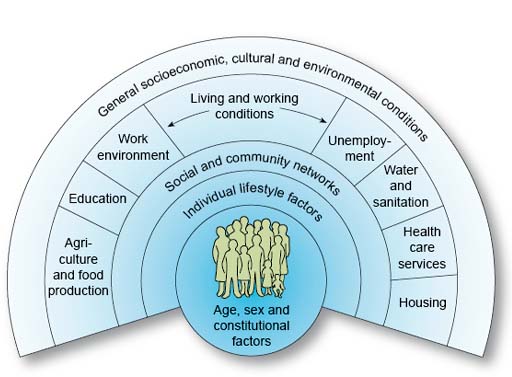1.2 Determinants of health
A young person’s social context can bring a wide range of factors to bear on their health and wellbeing. One of the most useful models for representing these factors is this one by Dahlgren and Whitehead (1993; cited in Dahlgren and Whitehead, 2007) in the figure below.
Dahlgren and Whitehead’s model has been widely used by academics and practitioners to guide their thinking about health.

Dahlgren and Whitehead’s model depict layers of influence on health. This model maps the relationship between the individual, their environment and health. Individuals are at the centre. Surrounding them are influences on health that can be modified. The first layer represents individual behaviour and lifestyle that can potentially enhance or damage health, for example the choice to smoke or not. The next layer refers to wider social and community influences, which can either provide mutual support or lack of support. The third layer represents structural factors, including housing, working conditions, access to services and provision of essential facilities.
The ‘age, sex and constitutional factors’ in this model apply to both the biomedical and the psychological perspectives, although each will focus on different ‘constitutional factors’. Individual lifestyle factors are also critical to the biomedical and psychological perspectives since diet, exercise and sleep, for example, can directly affect mental health, and mental health can affect lifestyle.
Activity 3: George’s social determinants
Study the diagram in Figure 3 and think for a moment about how they might apply to George.
Discussion
The wider range of factors related to the community and the person’s wider social, cultural and economic environment primarily make up the social determinants of health. In George’s case, many of the social factors, including his family situation, would fit in to the ‘social and community networks’ part of the model. If you were helping George, you might also consider what is happening in his education setting and whether the healthcare services were able to respond to his needs. Considering the socioeconomic conditions, if George lived in a relatively deprived community he would be more at risk of ill health than if he lived in a relatively affluent community (Marmot et al., 2020). Unfortunately, it is unlikely that an individual practitioner can change a young person’s socioeconomic circumstances.
A variety of professionals draw, to varying degrees, on this wide range of factors to make sense of a young person’s mental health. You’ll learn more about this next.
